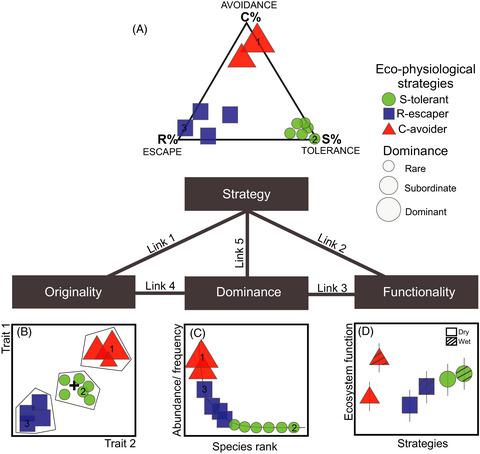Our official English website, www.x-mol.net, welcomes your feedback! (Note: you will need to create a separate account there.)
Three eco‐physiological strategies of response to drought maintain the form and function of a tropical montane grassland
Journal of Ecology ( IF 5.5 ) Pub Date : 2020-08-10 , DOI: 10.1111/1365-2745.13481 Ilaíne S. Matos 1 , Cleiton B. Eller 2 , Imma Oliveras 3 , Dulce Mantuano 4 , Bruno H. P. Rosado 1
中文翻译:

应对干旱的三种生态生理策略维持了热带山地草原的形式和功能
更新日期:2020-08-10
Journal of Ecology ( IF 5.5 ) Pub Date : 2020-08-10 , DOI: 10.1111/1365-2745.13481 Ilaíne S. Matos 1 , Cleiton B. Eller 2 , Imma Oliveras 3 , Dulce Mantuano 4 , Bruno H. P. Rosado 1
Affiliation

|
- Ecologists seek a general scheme to classify the diversity of plant responses to environmental factors into a few strategies (e.g. competitor—C, stress tolerant—S, ruderal—R), while plant physiologists seek a mechanistic scheme to explain such different responses (e.g. tolerance, escape, avoidance). So far, few attempts have been made to combine both perspectives into plant eco‐physiological strategies. Moreover, the relative contribution of different strategies to maintain both community structure and ecosystem functioning during drought has rarely been assessed. Thus, limiting our capacity to predict how extreme events caused by climate change will affect plant communities.
- Here, we present an integrated framework to identify plant eco‐physiological strategies and to estimate their contribution to community originality (diversity of trait combinations), dominance (species relative frequency) and ecosystem functioning (productivity and evapotranspiration).
- We applied this framework in a tropical montane grassland in Brazil (Campos de Altitude) and found three eco‐physiological strategies co‐occurring in this community (S‐tolerance/avoidance, CS‐escape/tolerance and CR‐escape/avoidance). While CS‐species contributed more to dominance and functionality, CR‐ and S‐species contributed more to originality. Therefore, all three strategies were important to support the grassland form and function.
- Synthesis. Plants exhibit different strategies, as well as different contributions to community and ecosystem attributes. We developed an integrated approach to both identify strategies and estimate their relative contribution. Thereby, as droughts intensify, we can better predict which plants are more likely to be lost and how their loss will impact the communities and ecosystem where they occur. This knowledge is necessary for specifying conservation priorities and for developing more efficient conservation practices.
中文翻译:

应对干旱的三种生态生理策略维持了热带山地草原的形式和功能
- 生态学家寻求一种通用方案,将植物对环境因素的响应分类为几种策略(例如,竞争者-C,耐胁迫-S,抗-R),而植物生理学家则寻求一种机械方案来解释这种不同的响应(例如耐性,逃避,回避)。到目前为止,几乎没有尝试将两种观点结合到植物生态生理策略中。此外,很少评估干旱期间维持社区结构和生态系统功能的不同策略的相对贡献。因此,限制了我们预测气候变化导致的极端事件将如何影响植物群落的能力。
- 在这里,我们提出了一个综合框架,以识别植物的生态生理策略,并评估其对社区原创性(性状组合的多样性),优势(物种相对频率)和生态系统功能(生产力和蒸散量)的贡献。
- 我们在巴西的热带山地草原(Campos de Altitude)上应用了该框架,并发现了该社区同时发生的三种生态生理策略(S-耐受/避免,CS-逃逸/耐受和CR-逃逸/避免)。CS物种对主导地位和功能的贡献更大,而CR和S物种对独创性的贡献更大。因此,这三种策略对于支持草地的形态和功能都很重要。
- 综合。植物表现出不同的策略,以及对社区和生态系统属性的不同贡献。我们开发了一种综合方法来识别策略并估计其相对贡献。从而,随着干旱的加剧,我们可以更好地预测哪些植物更容易丢失,以及它们的损失将如何影响它们所在的社区和生态系统。这些知识对于指定保护优先级和开发更有效的保护实践是必要的。



























 京公网安备 11010802027423号
京公网安备 11010802027423号